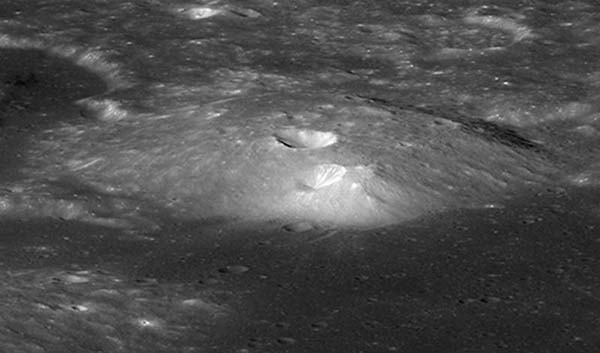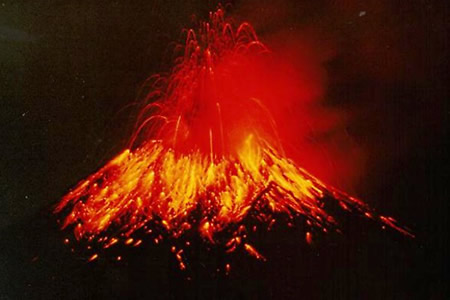Friday, September 26, 2008
Welcome!!!!!
Welcome to Volcano Voyage on this blog I will be informing you about volcanoes, e.g: Types, Past beliefs, etc. Hope you find what your looking for on my blog!!!!
Monday, September 22, 2008
Submarine Volcanoes

Submarine volcanoes are ordinary traits on the ocean floor. A few are active and, in shallow water, reveal their company by blasting steam and rocky rubble high over the exterior of the ocean. Countless others lie at great depths that the incredible weight of the water over them stop the explosive discharge of steam and gases, while they can be found by hydrophones and discoloration of water because of volcanic gases. Pumice rafts can show up aswell. Even large submarine eruptions might not upset the ocean's exterior. Because of the fast cooling effect of water as compared to air, and increased buoyancy, submarine volcanoes often form steep columns over their volcanic vents as compared to above surface volcanoes. They can become so big that they break the ocean surface as new islands. Pillow lava is a common eruptive creation of submarine volcanoes.
Picture URL:http://pubs.usgs.gov/gip/volc/fig29.gif
The picture is an example of a submarine volcano.
Friday, September 12, 2008


The Earth's Moon doesn't have any big volcanoes and no present volcanic activity, even though new evidence proposes it may still have a partially molten centre. But, the Moon does comprise of many volcanic features for example maria ,the darker patches seen on the moon, rilles and domes.
Venus has a surface that is ninety percent basalt, showing that volcanism played a key part in shaping it's surface. The planet may have had a main global resurfacing event about five hundred million years ago, from what scientists can tell from the density of impact craters on the surface. Lava flows are widespread and forms of volcanism not present on Earth occur as well. Changes in the planet's atmosphere and observations of lightning, have been credited to ongoing volcanic eruptions, although there is no confirmation of whether or not Venus is still volcanically active. However, radar sounding by the Magellan probe unveiled evidence for comparatively recent volcanic activity at Venus's highest volcano Maat Mons, in the form of ash flows near the top and on the northern flank.
There are several extinct volcanoes on Mars, four that are vast shield volcanoes, far bigger than any on Earth. They include Arsia Mons, Ascraeus Mons, Hecates Tholus, Olympus Mons, and Pavonis Mons. These volcanoes have been extinct for millions of years, but the European Mars Express spacecraft has found evidence that volcanic activity may have occurred on Mars in the recent past as well.
Venus has a surface that is ninety percent basalt, showing that volcanism played a key part in shaping it's surface. The planet may have had a main global resurfacing event about five hundred million years ago, from what scientists can tell from the density of impact craters on the surface. Lava flows are widespread and forms of volcanism not present on Earth occur as well. Changes in the planet's atmosphere and observations of lightning, have been credited to ongoing volcanic eruptions, although there is no confirmation of whether or not Venus is still volcanically active. However, radar sounding by the Magellan probe unveiled evidence for comparatively recent volcanic activity at Venus's highest volcano Maat Mons, in the form of ash flows near the top and on the northern flank.
There are several extinct volcanoes on Mars, four that are vast shield volcanoes, far bigger than any on Earth. They include Arsia Mons, Ascraeus Mons, Hecates Tholus, Olympus Mons, and Pavonis Mons. These volcanoes have been extinct for millions of years, but the European Mars Express spacecraft has found evidence that volcanic activity may have occurred on Mars in the recent past as well.
Picture URL:http://www.crystalinks.com/volmoon.jpg
The picture above is an example of a volcano on the moon.
Thursday, September 11, 2008
Past Beliefs Of Volcanic Eruptions

Many ancient stories credit volcanic eruptions to supernatural causes, such as the actions of gods or demigods. To the ancient Greeks, volcanoes' impulsive power could only be made clear as proceedings of the gods, while 16th-17th century German astronomer Johannes Kepler considered that they were tubes for the Earth's tears. One early idea to this was proposed by Jesuit Athanasius Kircher , who witnessed eruptions of Mount Etna and Stromboli, then visited the crater of Vesuvius and issued his view of a world with a central fire connected to many others caused by the burning of sulfur, bitumen and coal.
Different explanations were suggested for volcano behavior before the recent understanding of the Earth's mantle arrangement as a half solid material was developed. For decades after understanding that density and radioactive materials may be heat sources, their donations were explicitly reduced. Volcanic action was frequently credited to chemical responses and a thin layer of molten rock close to the exterior.
Different explanations were suggested for volcano behavior before the recent understanding of the Earth's mantle arrangement as a half solid material was developed. For decades after understanding that density and radioactive materials may be heat sources, their donations were explicitly reduced. Volcanic action was frequently credited to chemical responses and a thin layer of molten rock close to the exterior.
The picture above is an example of a volcano from prehistoric times.
Friday, September 5, 2008
Hot Spots

 Hotspots are not always found on the ridges of tectonic plates, but above matle plumes, where the heat of the Earth's mantle makes a column of hot material that increases until it get's to the crust, which is inclined to be slimmer than in other places of the Earth. The temperature of the plume makes the crust melt and create pipes, which can expel magma. Because the tectonic plates move but the mantle plume stays in the same place, each volcano becomes dormant after a period of time and a new volcano is then created as the plate moves over the hotspot. The Hawaiian Islands are thought to be produced in such a way, aswell as the Snake River Plain, with the Yellowstone Caldera being the section of the North American plate presently above the hotspot.
Hotspots are not always found on the ridges of tectonic plates, but above matle plumes, where the heat of the Earth's mantle makes a column of hot material that increases until it get's to the crust, which is inclined to be slimmer than in other places of the Earth. The temperature of the plume makes the crust melt and create pipes, which can expel magma. Because the tectonic plates move but the mantle plume stays in the same place, each volcano becomes dormant after a period of time and a new volcano is then created as the plate moves over the hotspot. The Hawaiian Islands are thought to be produced in such a way, aswell as the Snake River Plain, with the Yellowstone Caldera being the section of the North American plate presently above the hotspot.Picture URL:http://images.google.ie/imgres?imgurl=http://www.greenpeace.org/raw/image_full/russia/en/photosvideos/photos/lake-troitskoe-in-the-volcano.jpg&imgrefurl=http://www.greenpeace.org/russia/en/photosvideos/photos/lake-troitskoe-in-the-volcano&h=323&w=430&sz=72&hl=en&start=30&usg=__BJhvZFxicsT6lhmkHQ2eU3UTWSg=&tbnid=g5YGJQDdW_bfmM:&tbnh=95&tbnw=126&prev=/images%3Fq%3Dvolcano%26start%3D20%26gbv%3D2%26ndsp%3D20%26hl%3Den%26sa%3DN
The picture above is an example of a dormant volcano.
Friday, August 29, 2008
Types of Volcanoes

A popular way of categorising magmatic volcanoes is by their rate of eruption, with those that erupt regularly called active, those that have erupted in historical times but are now quiet are called dormant, and those that have not erupted in historical times are called extinct. But, these popular categories, extinct especially are practically meaningless to scientists. They use categories which consign to a particular volcano's formative and eruptive processes and resulting shapes, which was explained above.
There is no real disagreement among volcanologists on how to describe an active volcano. The lifetime of a volcano can change from months to several million years, making such a distinction sometimes meaningless when compared to the lifetime of humans or even civilizations. For example, many of the Earth's volcanoes have erupted dozens of times in the past but are not currently showing signs of eruption. Given the long lifespan of such volcanoes, they are very active. By human lifespans, however, they are not.
Scientists usually consider a volcano to be active if it is currently erupting or showing signs of unrest, such as unusual earthquake activity or significant new gas emissions. Many scientists also consider a volcano active if it has erupted in historic time. It is important to note that the span of recorded history differs from region to region; in the Meditteranean, recorded history reaches back more than 3,000 years but in the Pacific Northwest of the United States, it reaches back less than 300 years, and in Hawaiii, little more than 200 years. The Smithsonian Global Volcanism Program's definition of 'active' is having erupted within the last 10,000 years.
Picture URL:http://images.google.ie/imgres?imgurl=http://geology.com/news/images/tungurahua-volcano.jpg&imgrefurl=http://geology.com/news/labels/Volcanoes.html&h=300&w=450&sz=32&hl=en&start=1&usg=__yRHuUT6FEv-ImFK0un8-rXK-p9A=&tbnid=fJSwvSO6kG1-_M:&tbnh=85&tbnw=127&prev=/images%3Fq%3Dvolcano%26gbv%3D2%26hl%3Den
The picture above is an example of an erupting volcano.
This video is an example of a volcanic eruption. Follow the link to watch it, the video is provided by googlevideo.com
Video URL:http://video.google.com/videoplay?docid=1549454720556565216&hl=en
Subscribe to:
Posts (Atom)